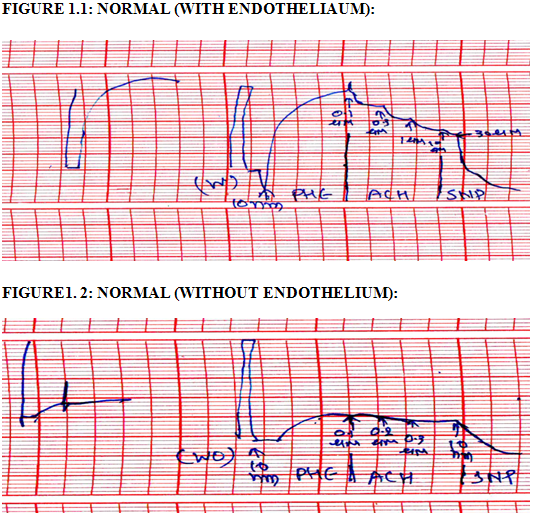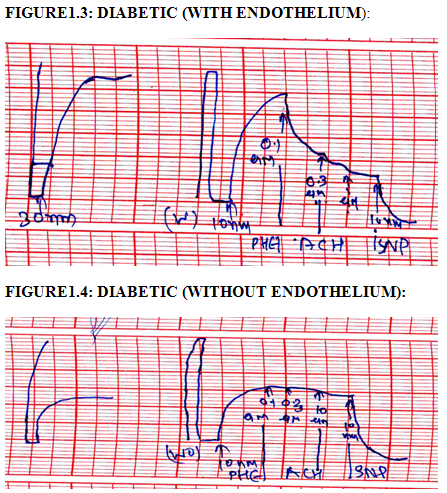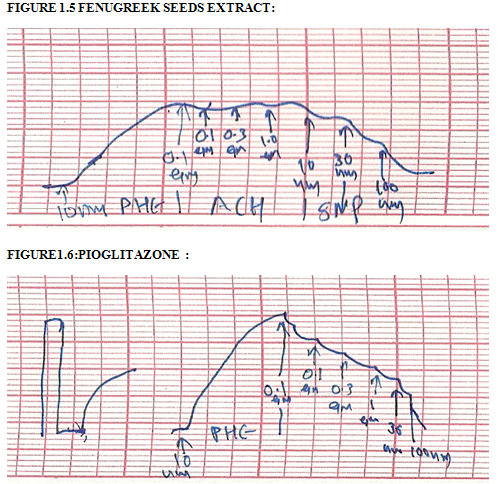 About Authors:
About Authors:
ATUL KABRA* , PREMAL KAPADIA
Department of Pharmacology,
G.H.B Pharmacy college,
Aniyad, Gujarat
* atul.kbr@gmail.com
ABSTRACT:
The cardiovascular risk factors were significantly abnormally altered in diabetic rats when compared to normal control. The present study FLEt with low dose of OHA’s indicates the significant improvement in endothelial dependent vasodilatation because the percentage relaxation produced by acetylcholine was more significant when these groups were compared with diabetic control.However all the treated groups restored these changes significantly to normal conditions in diabetic rats when compared to diabetic control. The combined therapy of FLEt and Fluvastatin was found to be significantly effective. Moreover, this combination was also found to demonstrate synergistic behavior than pioglitazone plus fluvastatin.
We conclude that of preventive therapy with combination of FLEt with OHA’s (low dose) may prevent the endothelial dysfunction in diabetic patients (prediabetic state) due to free radical scavenging activity, metabolic control.
[adsense:336x280:8701650588]
Reference Id: PHARMATUTOR-ART-1340
INTRODUCTION:
Obesity is usually the result of the combination of genetic factors with an inappropriate lifestyle, characterized by inadequate nutrition and lack of regular physical activity and is associated with development of diabetes, dyslipidemia hypertension and other medical problems1.
Diabetes is of two types:
1. Insulin dependent diabetes(Type-I)
2. Non-insulin dependent diabetes(Type-II)
Type-I diabetes is a chronic disease characterized by hyperglycaemia secondary to inadequat production of insulin by the pancreas. It is due to complete destruction of β cells. It may be
1.Immune mediate
2.Idiopathic2.
Type II diabetes is a result from a defect of both insulin secretion and insulin sensitivity. Other factors responsible for
Pathogenesis of diabetes II may be
1. Genetics and/or environment in the early life
2.β cell dysfunction3.
Diabetes is a multisystem disorder that brings about microvascular and macrovascular complications4.
The pharmacodynamic interaction of Fenugreek leaves extract (Rich in polyphenol) and fluvastatin in diabetic induced vascular dysfunction is not studied until now. Hence an attempt is made to study the effect of Fenugreek leaves extract with fluvastatin in diabetes induced vascular dysfunction in rats.
[adsense:468x15:2204050025]
MATERIAL AND METHODS:
Experimental Animals:
Male Sprague dawley Rats weighing 150-180 g were housed at 25° ± 5°C in a well-ventilated animal house under 12:12 h light dark cycle. The animals were maintained under standard conditions in an animal house as per the guidelines of Committee for the Purpose of Control and Supervision on Experiments on Animals (CPCSEA).
Extraction of polyphenolic rich Fenugreek leaves:
Preparation of Fenugreek Leaves Extract:
Fenugreek Leaves (500 g) were finely powdered, mixed with 80% methanol and kept at room temperature for 5 days. After 5 days it was filtered and the solvent was evaporated. The residue was dissolved in water and the aqueous layer was washed with petroleum ether several times until a clear upper layer of petroleum ether was obtained. The lower layer was then treated with ethyl acetate containing glacial acetic acid (10 ml/l).Extraction of polyphenols was carried out for 36 h at room temperature and the combined ethyl acetate layer was concentrated). The residue was lyophilized and stored. This yielded about 6–8 g per 500 g of leaves powder. An Methanolic extract was prepared and used for the studies.
INDUCTION OF DIABETES:
Development of high fat diet (HFD) fed / Low dose streptozotocin Treated type 2 diabetic rats:
The animals were fed with HFD once a day for two weeks followed by I.P injection of streptozotocin (35mg/kg) dissolved in 0.5M/l citrate buffer ( pH: 4.4) after over night fasting. STZ injected animals were then given 5% w/v glucose solution for 5-6 hours following the injection to prevent initial drug induced hypoglycemic mortality. The rats with non fasted plasma level ≥ 300mg/dl were considered diabetic. The blood Sample was collected from tail vein and blood glucose was checked using glucose diagnostic kit (accucheck) .
STANDARDISATION AND SELECTION OF LOW DOSE FOR STANDARD DRUGS:
Oral Glucose Tolerance Test: After overnight fasting(18hrs), a 0-min blood sample was taken from the tip of the tail of each rat of different groups. Glucose solution (2 g/kg P.O) was given after 30 min after the administration of the drug . Four more samples were taken at 30, 60, 90 and 120 min after glucose administration . All blood samples were checked with the help of accucheck glucometer.
The oral glucose tolerance test will be performed on overnight fasted Sprague dawley rats. Rats will be divided into different groups as follows:
Group 1: Normal control, rats receive saline/vehicle.
Group 2: Diabetic control.
Group 3:Fenugreek leaves extract(200 mg/kg)
Group 4: Pioglitazone (10 mg/kg)
Group 5: Glipizide (5 mg/kg)
Effect of fenugreek leaves extract alone and in combination with oral hypoglycemic agents in streptozotocin induced diabetic vascular dysfunction:
Rats was divided into different groups (n=6) as follows and the treatment with the respective drugs was given for 8 weeks. The estimations was carried out on the 15th, 30th, 45th and 60th days of the treatment.
Group 1: Normal control, rats receive saline/vehicle.
Group 2: Diabetic control
Group3: FSEt (200 mg/kg p.o)5
Group 4: Pioglitazone (10 mg/kg)6
Group 5: Glipizide (5mg/kg)7
Group 6: Pioglitazone (7.5mg/kg) plus Glipizide (3.75mg/kg)
Group 7: pioglitasone + Fluvastatin (10MG/KG)8
Group 7 : Pioglitazone(7.5 mg/kg )+ FSPE (200mg/kg)
Group 10: Glipizide (3.75 mg/kg) + FLEt (200 mg/kg)
Group 11: Glipizide (3.75 mg/kg) + FLEt (200 mg/kg)
Group12: FLEt (200 mg/kg) + Fluvastatin
NOW YOU CAN ALSO PUBLISH YOUR ARTICLE ONLINE.
SUBMIT YOUR ARTICLE/PROJECT AT articles@pharmatutor.org
Subscribe to PharmaTutor Alerts by Email
FIND OUT MORE ARTICLES AT OUR DATABASE
EXPERIMENTAL ANIMAL MODELS:
Isolated Rat Aortic ring preparation:
The rat aortic preparations were isolated, mounted in a temperature controlled tissue/organ bath and suspended in K-H solution that was aerated with carbogen gas so as to maintain the isolated tissues in a physiological state i.e. in a viable state during the experimental period.Thus using the tissue /organ bath the necessary physiological warmth is provided to the tissue even after isolation from the animal while the K-H solution is used to provide the essential medium containing the various ions, buffer, energy source etc. but also to supply oxygen requirements to the isolated tissue.
RESULTS:
Table-1.Effect of FLEt and its combination with Oral Hypoglycemic Agents on OGTT in Normal rats:
|
TIME |
FBS |
0 min |
30 min |
60min |
120 min |
|
NC |
84±1.1 |
103 .1±1.5
|
120.6±0.8 (↑16%) |
114 .71 ±1.5 (↑10%) |
86 .2± 0.6 (↓17%) |
|
DC |
205±2.5 |
214± 1.4
|
289 ±2.6 (↑35%) |
288.3 ±3.0 (↑34.5%) |
285.4±2.1 (↑33%) |
|
FLEt |
86.3 ±1.20 |
91 .33± 1.0
|
108.12± 4.1 (↑18.68%) |
104.42±1.9 (↑14%)a |
88 .90±0.8 (↓4%)a |
|
P |
85.6 ±1.20 |
93 .04 ±1.2
|
120.1±3.4 (↑29%) |
112.33±1.6 (↑20%)c |
80.8 ±2.8 (↓3%)a |
|
G |
88.20 ±0.57 |
90.3 ±1.2
|
116.66 ±3.1 (↑28.8%) |
102.12±0.6 (↑13%)a |
84.99±0.5 (↓6%)a |
|
P+G |
89. 07 ±0.5
|
90.33± 0.5
|
106 ±0.5 (↑17.7%) |
99 ±0.8 (↑9%)a |
70.22± 0.9 (↓23%)a |
|
P+ FLEt |
86.1 ±0.5
|
90.32±0.88
|
110.9±0.9 ( ↑20%) |
102 ±1.8 (↑15%)b |
85.77± 0.8 (↓5.1% )a |
|
G+ FLEt |
82.66± 0.3 |
86.66± 1.7
|
102.8±3.8 (↑15.9%) |
96± 2.2 (↑11.6%)a |
82.1± 0.7 (↓5%)a |
All values are mean ± SEM, n=6,a P<0.001, bP<0.01, cP<0.05 when compared to normal control group.
Table-2. Effect of FLEt and its combination with Oral Hypoglycemic Agents on OGTT in Diabetic rats:
|
TIME |
FBS |
0 min |
30 min |
60min |
120 min |
|
NC |
89.26 ±1.2 |
98.34± 1.9
|
104.1 ±2.0 (↑6%) |
112.90± 0.9 (↑15.3%) |
90.21± 2.1 (↑2.8%) |
|
DC |
188.06±3.9 |
212.11 ±0.8
|
249.2± 0.8 (↑17.5%)
|
298.14 ±0.8 (↑40%) |
306.3±0.1 (↑44%) |
|
FLEt |
179.26 ±0.7 |
189.22±1.5
|
208.9± 3.3 (↑10.4%)b |
222 ±1.2 (↑17%)a |
186.1±1.7 (↓2%)a |
|
P |
184.43± 0.4 |
201.66 ±1.2
|
236.67 ±3.2 (↑17.4%)c |
257.45 ±4.1 (↑27%)c |
212.7±5.0 (↑5.5%)b |
|
G |
197.26±0.9 |
203.67±2.1
|
229.88±2.4 (↑12.56%)b |
243.5±4.3 (↑20%)a |
180±2.9 (↓12.4%)a |
|
P+G |
168.8.±0.5
|
174.29±2.3
|
198.74±0.8 (↑8%)c
|
208±1.9 (↑19%)a |
143.1±1.8 (↓18%)a |
|
P+ FLEt |
170.14±1.9 |
190.2±3.9 (↑11%) |
211.67±4.0 (↑11%)c |
248.15±2.8 (↑30%)c |
194.8±1.8 (↑14%)b |
|
G+ FLEt |
182.88±1.5
|
189.12±1.7
|
209.37±2.2 (↑3%)b
|
219.76±2.1 ( ↑15%)a |
187.4±0.6 (↓2%) |
All values are mean ± SEM, n=6,a P<0.001, bP<0.01, cP<0.05 when compared to diabetic control group.
Table 3: Effect of FLEt and its combination with Oral Hypoglycemics on Blood Glucose (mg/dl)
|
Groups |
0th day |
15th day |
30th day |
45th day |
60th day |
75th day |
||||||
|
NC |
|
124±0.8 |
123.2±0.12 |
126±0.24 |
128±0.5 |
122±0.5 |
123±0.8 |
|||||
|
DC |
|
265±0.5 |
273.5±0.2 |
291.8±0.9 |
332.8±0.4 |
395.2±0.5 |
418±0.4 |
|||||
|
FLEt |
|
241±0.1 |
248.4±0.8b |
235.8±0.5b |
228.4±0.6b |
219.4±0.5b |
139±0.9a |
|||||
|
P |
|
245±0.8 |
252.5±0.5c |
241.2±1.8c |
234.6±0.8c |
225.8±0.6c |
148±0.7a |
|||||
|
G |
|
270±0.5 |
261±0.6c |
248.1±2.3c |
224.7±0.4c |
194.4±0.4c |
143±0.4a |
|||||
|
P+G |
|
241±0.5 |
222.8±1.7a |
202.5±0.7a |
161.1±0.5a |
89.1±0.5a |
- |
|||||
|
P+FLEt |
|
251±0.7 |
237.8±0.5b |
228.6±1.2b |
218.8±0.5b |
183.5±1.5b |
137±0.1a |
|||||
|
G+FLEt |
|
262±0.6 |
244±0.4a |
229.4±0.8b |
194.7±0.6a |
164.7±0.8a |
131±0.1a |
|||||
FLEt:- Fenugreek leaves exteact.
All values are mean ± SEM, n=6,a P<0.001, bP<0.01, cP<0.05 when compared to diabetic control group
Table:4 Comparison of relaxant responses in treated groups:
|
TREATMENT |
Percentage relaxant response to |
SNP |
||
|
ACETYLCHOLINE |
||||
|
0.1 (µM) |
0.3 (µM) |
(1.0 µM) |
||
|
NORMAL Mean SEM |
28.35 ±3.458 |
32.37 ±3.876 |
56.56 ±4.467 |
101.00 ±1.98 |
|
DIABETIC Mean ±SEM |
9.07 ±2.345 |
14.76 ±3.234 |
20.67 ±4.778 |
103.00 ±2.87 |
|
FLEt Mean ±SEM |
17.61b ±0.253 |
21.45b ±0.773 |
24.88b ±0.197 |
105.00 ±3.12 |
|
PIO Mean ±SEM |
12.82c ±0.287 |
16.52c ±0.545 |
20.01c ±0.345 |
102.00 ±1.87 |
|
GLIP Mean ±SEM |
15.54c ±0.548 |
17.64c ±0.550 |
22.98c ±0.791 |
101.00 ±2.34 |
|
PIO+GLIP Mean ±SEM |
16.21b ±0.454 |
22.81b ±0.657 |
35.87b ±0.965 |
103.00 ±3.05 |
|
FLEt+PIO Mean ±SEM |
15.20b ±0.505 |
27.60b ±0.724 |
37.98b ±0.876 |
101.00 ±1.05 |
|
FLEt+GLIP Mean ±SEM |
16.43b ±0.327 |
25.70b ±0.479 |
34.76b ±0.876 |
103.98 ±3.76 |
|
FLEt+FLU Mean ±SEM |
14.54a ±0.347 |
24.74a ±0.733 |
36.34a ±0.879 |
101.00 ±1.89 |
|
P+FLU Mean ±SEM |
12.86a ±0.291 |
20.87a ±0.539 |
32.90a ±0.678 |
103.00 ±2.67 |
|
G+FLU Mean ±SEM |
14.70a ±0.305 |
23.53a ±0.783 |
38.57a ±0.375 |
102.00 ±2.23 |
All values are mean ± SEM, n=6,a P<0.001, bP<0.01, cP<0.05 when compared to diabetic control group
NOW YOU CAN ALSO PUBLISH YOUR ARTICLE ONLINE.
SUBMIT YOUR ARTICLE/PROJECT AT articles@pharmatutor.org
Subscribe to PharmaTutor Alerts by Email
FIND OUT MORE ARTICLES AT OUR DATABASE
FIGURE 1:GRAPHS OF TREATED GROUPS:






CONCLUSION:
Endothelial dysfunction associated with insulin resistance appears to precede the development of overt hyperglycemia in patients with type 2 diabetes mellitus. Therefore, endothelial dysfunction may be a critical early target for the prevention of atherosclerosis and CVD in patients with diabetes mellitus or insulin resistance. Therefore preventive therapy with combination of FLEt with OHA’s (low dose) may prevent the endothelial dysfunction in diabetic patients (prediabetic state) due to free radical scavenging activity, metabolic control.
REFERENCES:
1.Pi-Sunyer FX. The obesity epidemic: pathophysiology and consequences of obesity. Obes Res 2002;10:97–104.
2.Thrower SL, Bingley PJ. What is type I diabetes? Medicine 2010;38:592-596.
3.Virally M, Blickle JF, Girard F, Halimi S, Simon D. Type 2 diabetes mellitus: epidemiology, pathophysiology, unmet needs and therapeutical perspectives. Diabetes Metab 2007;33:231–244.
4.Mark WS, Robert JC. Type 2 Diabetes, Cardiovascular Risk and the Link to Insulin Resistance. Clin Ter 2003;25:4-31.
5.Xia J, Allenbrand B, Sun GY. Dietary supplementation of grape polyphenols and chronic ethanol administration on LDL oxidation and platelet function in rats. Life Sci 1998;63:383–390.
6.Lee MY, Lee EY, Lee BJ, Won CS, Koh JH. Beneficial effect of thiazolidinediones on diabetic neuropathy in OLETE rats. Yom sei Med J 2007;48:301-307.
7.Hosszufausi N, Reinhers L, Takei S, Chan E, Charles MA. Glipizide induced prevention of diabetic and autoimmune events in BB rats. J A Autoimmun 1994; 9:753-761.
8.Lee TM, Lin MS, Chau TF, Chang NC. Additive effects of combined blockade of AT1 receptors and HMG-Co-A reductase on left ventricular remodeling in infracted rats. Am J Physiol Heart Cir Physiol 2006;291:128-129.
NOW YOU CAN ALSO PUBLISH YOUR ARTICLE ONLINE.
SUBMIT YOUR ARTICLE/PROJECT AT articles@pharmatutor.org
Subscribe to PharmaTutor Alerts by Email
FIND OUT MORE ARTICLES AT OUR DATABASE










